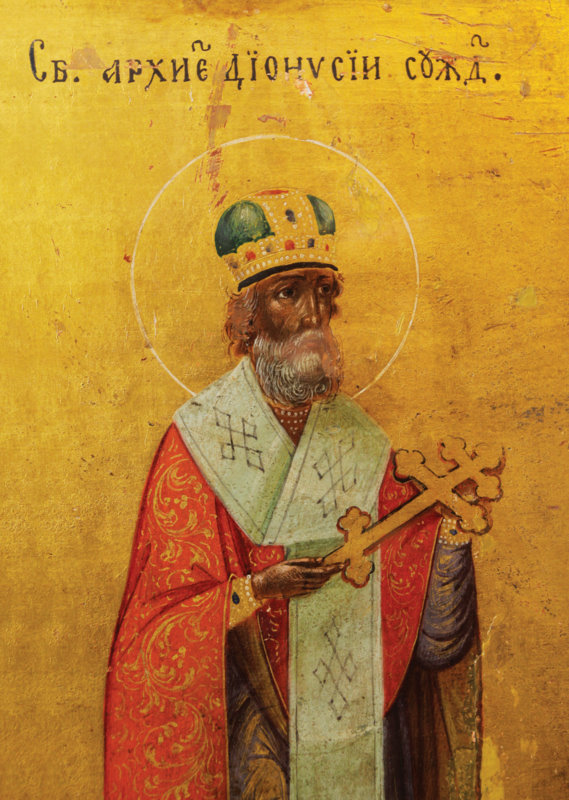Dionysius of Suzdal, metropolitan of Kiev and all Russia, holy hierarch
Dates of commemoration
(Church calendar - Aug 28) Synaxis of all saints of Nizhny Novgorod (movable feast on the Sunday after August 26th)
Life
Dionysius, Archbishop of Suzdal, in the world David, was tonsured at the Kiev Caves monastery. He arrived at the Volga with an icon of the Mother of God that he had received as a blessing from Saints Anthony and Theodosius. Saint Dionysius dug out a cave not far from Nizhni-Novgorod and struggled in total solitude. Brethren constantly thronged to the holy ascetic and in the year 1335 he founded a monastery in honor of the Ascension of the Lord. Among his students of Saint Dionysius were Saints Euthymius of Suzdal (April 1) and Macarius of Zheltovod and Unzha (July 25). In the year 1352 the holy Elder sent twelve of his brethren to “the upper cities and countryside, whom God would bless” for the spiritual enlightenment of the people and the organizing of new monasteries. The monastery of Saint Dionysius exerted a deep charitable influence on the inhabitants of Nizhni-Novgorod. In the year 1371 the saint tonsured into monasticism the forty-year-old widow of Prince Andrew Constantinovich, an example of how he accepted into monasticism “various dignitaries: women, widowers, and virgins.”
In the year 1374 Saint Dionysius was deemed worthy of the office of bishop. His years of service as bishop occurred during a remarkable period, for Russia was rising to cast off the Mongol-Tatar Yoke. On March 31, 1375 the Tatar military-chief, having been shown to the bishop’s court by the enslaved inhabitants of Nizhni-Novgorod, shot an arrow at Saint Dionysius, but the Lord preserved his chosen one, and the arrow struck only the bishop’s mantle. In 1377, through the blessing of Saint Dionysius (who may have edited the document), the Lavrentian Chronicle was compiled by Saint Laurence, inspiring Russia in its struggle for freedom.
In 1379, preserving the integrity of the first hierarch’s cathedra, Saint Dionysius was one of the bishops gathered in Moscow by order of the prince, and he came out against the election of the prince’s protegee, the ill-reputed archimandrite Mityaya as Metropolitan.
In the same year of 1379 Saint Dionysius journeyed to Constantinople with a protest against the choice of Mityaya on grounds of his complicity with the heretical Strigolniki. The saint made a strong impression upon the Greeks by his sublime spiritual frame of mind and his profound knowledge of Holy Scripture. Patriarch Nilus, having termed the saint “a warrior of God and a spiritual man,” wrote that he himself saw him “at fasting and charity, and vigil, and prayers, and tears, and every other virtue.” From Constantinople Saint Dionysius sent two copies of the Hodigitria Icon of the Mother of God to a Council at Suzdal. In 1382 the bishop received the title of archbishop from the patriarch. Returning to Russia, the saint travelled to Pskov and Novgorod to struggle against the heresy of the Strigolniki.
He visited Constantinople a second time in 1383 for discussion with the patriarch on questions about the governance of the Russian metropolitanate. In the year 1384 Saint Dionysius was made “metropolitan for Russia” by Patriarch Nilus. But upon his return to Kiev the saint was arrested on orders of the Kiev prince Vladimir Olgerdovich and subjected to imprisonment, where he died on October 15, 1385. The burial of the saint was in “the Kiev Cave of the Great Anthony.” Saint Dionysius is commemorated on June 26 because it is the Feast of his patron saint, Saint David of Thessalonica, whose name he was given in Baptism. In the Synodikon of the 1552 Nizhni-Novgorod Caves monastery, Saint Dionysius is called a “wonderworking monk”
Source:
https://oca.org/saints/lives/2017/06/26/101820-st-dionysius-the-archbishop-of-suzdal
Holy relic type
unless specified otherwise below, "holy relic" means a fragment of a bone of the saint
Location of the holy relic in the Cathedral:
Troparion
Тропарь святителя Дионисия, архиепископа Суздальского, глас 8
Православия ревнителю, благочестия наставниче,/ ищущим спасения добрый кормчий,/ монашествующих Богодухновенное украшение,/ Богоноснаго Евфимия собеседниче, святителю Дионисие,/ ученьми и добродетельми отечество твое просветил еси,/ не забуди нас, чтущих тя,/ но в мире управи живот наш.
Kontakion
Кондак святителя Дионисия, архиепископа Суздальского, глас 8
Звезду Российскую от Киева возсиявшую/ чрез Нижний Новград в Суждаль достигшую,/ и всю страну сию учением озарившую,/ ублажим Богомудраго Дионисия,/ той бо молится Господу спастися душам нашим.






